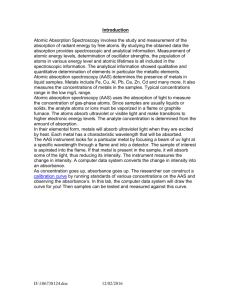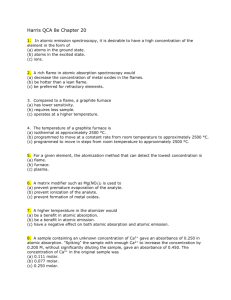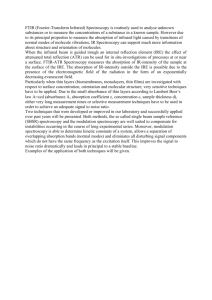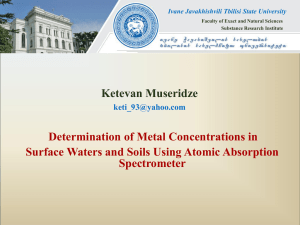Intro to Optical Methods in Analytical Chemistry
advertisement
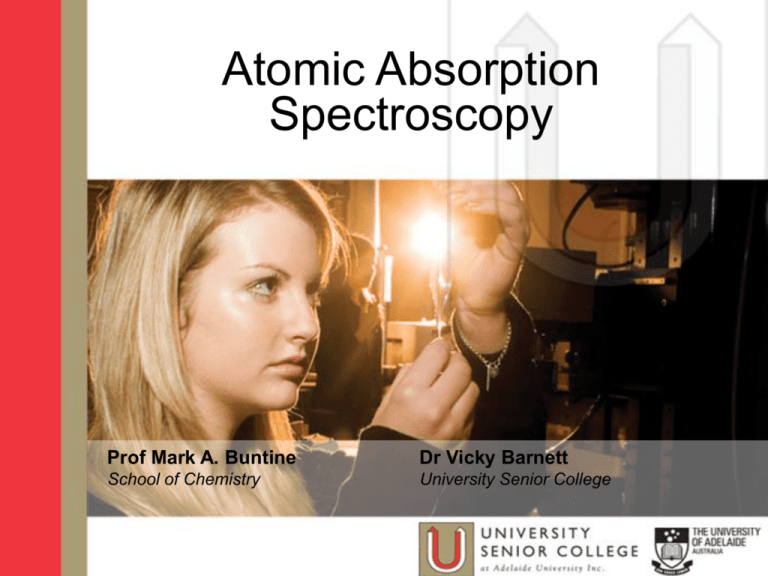
Atomic Absorption
Spectroscopy
Prof Mark A. Buntine
Dr Vicky Barnett
School of Chemistry
University Senior College
1
Atomic Absorption
Spectroscopy
“This material has been developed as a part of
the Australian School Innovation in Science,
Technology and Mathematics Project funded by
the Australian Government Department of
Education, Science and Training as a part of the
Boosting Innovation in Science, Technology and
Mathematics Teaching (BISTMT) Programme.”
2
Professor Mark A. Buntine
Badger Room 232
mark.buntine@adelaide.edu.au
Atomic Absorption Spectroscopy
• AAS is commonly used for metal analysis
• A solution of a metal compound is sprayed into
a flame and vaporises
• The metal atoms absorb light of a specific
frequency, and the amount of light absorbed is
a direct measure of the number of atoms of
the metal in the solution
4
Atomic Absorption Spectroscopy:
An Aussie Invention
• Developed by Alan Walsh (below) of the
CSIRO in early 1950s.
5
Electromagnetic Radiation
Sinusoidally oscillating electric (E) and magnetic (M) fields.
Electric & magnetic fields are orthogonal to each other.
Electronic spectroscopy concerns interaction of the
electric field (E) with matter.
6
The Electromagnetic Spectrum
• Names of the regions are historical.
• There is no abrupt or fundamental change in going
from one region to the next.
• Visible light represents only a very small fraction of
the electromagnetic spectrum.
Frequency (Hz)
1020
1018
-rays
X-rays
10-11
Wavelength (m)
1016
1014
1012
UV
10-8
Microwave
IR
10-6
108
10-3
Visible
7
400
500
600
700
800 nm
The Visible Spectrum
l < 400 nm, UV
400 nm < l < 700 nm, VIS
l > 700 nm, IR
8
The Electromagnetic Spectrum
• Remember that we are dealing with light.
• It is convenient to think of light as particles
(photons).
• Relationship between energy and frequency is:
E h
9
Energy & Frequency
• Note that energy and frequency are directly
proportional.
• Consequence: higher frequency radiation is
more energetic.
E.g. X-ray radiation ( = 1018 Hz): 4.0 x 106 kJ/mol
IR radiation ( = 1013 Hz):
39.9 kJ/mol
(h = 6.626 x 10-34 J.s)
10
Energy & Wavelength
• Given that frequency and wavelength are
related: l=c/
• Energy and wavelength are inversely
proportional
• Consequence: longer wavelength radiation
is less energetic
eg. -ray radiation (l = 10-11 m): 1.2 x 107 kJ/mol
Orange light (l = 600 nm): 199.4 kJ/mol
(h = 6.626 x 10-34 J.s
c = 2.998 x 108 m/s)
11
Absorption of Light
• When a molecule absorbs a photon, the
energy of the molecule increases.
Ground
state
photon
Excited
state
• Microwave radiation stimulates rotations
• Infrared radiation stimulates vibrations
• UV/VIS radiation stimulates electronic
transitions
• X-rays break chemical bonds and ionize
molecules
12
Absorption of Light
• When light is absorbed by a sample, the
radiant power P (energy per unit time per
unit area) of the beam of light decreases.
• The energy absorbed may stimulate
rotation, vibration or electronic transition
depending on the wavelength of the
incident light.
13
Atomic Absorption Spectroscopy
• Uses absorption of light to measure the
concentration of gas-phase atoms.
• Since samples are usually liquids or solids, the
analyte atoms must be vapourised in a flame (or
graphite furnace).
14
Absorption and Emission
Excited States
Ground State
Absorption
Emission
Multiple
Transitions
15
Absorption and Emission
Excited States
Ground State
Absorption
Emission
16
Atomic Absorption
• When atoms absorb light, the incoming
energy excites an electron to a higher
energy level.
• Electronic transitions are usually
observed in the visible or ultraviolet
regions of the electromagnetic spectrum.
17
Atomic Absorption Spectrum
• An “absorption spectrum” is the
absorption of light as a function of
wavelength.
• The spectrum of an atom depends on its
energy level structure.
• Absorption spectra are useful for
identifying species.
18
Atomic Absorption/Emission/
Fluorescence Spectroscopy
19
Atomic Absorption Spectroscopy
• The analyte concentration is determined
from the amount of absorption.
20
Atomic Absorption Spectroscopy
• The analyte concentration is determined from
the amount of absorption.
21
Atomic Absorption Spectroscopy
• Emission lamp produces light frequencies unique to
the element under investigation
• When focussed through the flame these frequencies
are readily absorbed by the test element
• The ‘excited’ atoms are unstable- energy is emitted
in all directions – hence the intensity of the focussed
beam that hits the detector plate is diminished
• The degree of absorbance indicates the amount of
element present
22
Atomic Absorption Spectroscopy
• It is possible to measure the concentration of
an absorbing species in a sample by applying
the Beer-Lambert Law:
I
Abs log
Io
= extinction coefficient
Abs cb
23
Atomic Absorption Spectroscopy
• But what if is unknown?
• Concentration measurements can be made
from a working curve after calibrating the
instrument with standards of known
concentration.
24
AAS - Calibration Curve
• The instrument is calibrated before use by testing the
absorbance with solutions of known concentration.
• Consider that you wanted to test the sodium content of
bottled water.
• The following data was collected using solutions of
sodium chloride of known concentration
Concentration (ppm)
Absorbance
2
4
6
8
0.18 0.38 0.52 0.7625
Calibration Curve for Sodium
A
b
s
o
r
b
a
n
c
e
1.0
0.8
0.6
0.4
0.2
2
4
6
Concentration (ppm)
8
26
Use of Calibration curve to determine sodium
concentration {sample absorbance = 0.65}
A
b
s
o
r
b
a
n
c
e
1.0
0.8
0.6
0.4
Concentration
Na+ = 7.3ppm
0.2
2
4
6
Concentration (ppm)
8
27
Atomic Absorption Spectroscopy
• Instrumentation
• Light Sources
• Atomisation
• Detection Methods
28
Light Sources
• Hollow-Cathode Lamps (most common).
• Lasers (more specialised).
• Hollow-cathode lamps can be used to detect
one or several atomic species simultaneously.
Lasers, while more sensitive, have the
disadvantage that they can detect only one
element at a time.
29
Hollow-Cathode Lamps
• Hollow-cathode lamps are a type of
discharge lamp that produce narrow
emission from atomic species.
• They get their name from the cup-shaped
cathode, which is made from the element(s)
of interest.
30
Hollow-Cathode Lamps
• The electric discharge ionises rare gas
(Ne or Ar usually) atoms, which in turn, are
accelerated into the cathode and sputter
metal atoms into the gas phase.
31
Hollow-Cathode Lamps
32
Hollow-Cathode Lamps
• The gas-phase metal atoms collide with
other atoms (or electrons) and are excited to
higher energy levels. The excited atoms
decay by emitting light.
• The emitted wavelengths are characteristic
for each atom.
33
Hollow-Cathode Lamps
M*
collision-induced
excitation
M+e
M*
M + Ar*
M*
M
M*
spontaneous
emission
M
M*
M + h
34
Hollow-Cathode Spectrum
Harris Fig. 21-3:
Steel hollowcathode
35
Atomisation
• Atomic Absorption Spectroscopy (AAS) requires
that the analyte atoms be in the gas phase.
• Vapourisation is usually performed by:
– Flames
– Furnaces
– Plasmas
36
Flame Atomisation
• Flame AAS can only analyse solutions.
• A slot-type burner is used to increase
the absorption path length (recall BeerLambert Law).
• Solutions are aspirated with the gas
flow into a nebulising/mixing chamber
to form small droplets prior to entering
the flame.
37
Flame Atomisation
Harris
Fig 21-4(a)
38
Flame Atomisation
• Degree of atomisation is temperature
dependent.
• Vary flame temperature by fuel/oxidant
mixture.
Fuel
Acetylene
Acetylene
Acetylene
Hydrogen
Hydrogen
Cyanogen
Oxidant
Temperature (K)
Air
2,400 - 2,700
Nitrous Oxide
2,900 - 3,100
Oxygen
3,300 - 3,400
Air
2,300 - 2,400
Oxygen
2,800 - 3,000
Oxygen
4,800
39
Furnaces
• Improved sensitivity over flame sources.
• (Hence) less sample is required.
• Generally, the same temp range as flames.
• More difficult to use, but with operator skill
at the atomisation step, more precise
measurements can be obtained.
40
Furnaces
41
Furnaces
42
Inductively Coupled Plasmas
• Enables much higher temperatures to be
achieved. Uses Argon gas to generate the
plasma.
• Temps ~ 6,000-10,000 K.
• Used for emission expts rather than absorption
expts due to the higher sensitivity and elevated
temperatures.
• Atoms are generated in excited states and
spontaneously emit light.
43
Inductively Coupled Plasmas
• Steps Involved:
– RF induction coil wrapped around a gas
jacket.
• Spark ionises the Ar gas.
• RF field traps & accelerates the free
electrons, which collide with other atoms
and initiate a chain reaction of ionisation.
44
Detection
• Photomultiplier Tube (PMT).
pp 472-473 (Ch. 20) Harris
45
Photomultiplier Tubes
• Useful in low intensity applications.
• Few photons strike the photocathode.
• Electrons emitted and amplified by dynode
chain.
• Many electrons strike the anode.
46
